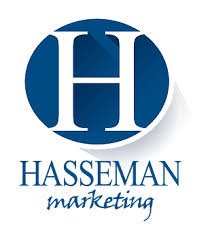by Kirby Hasseman
When it comes to marketing our organization, everyone wants to make sure they are up on the latest tips and tactics. And we are here for it. Our goal is to keep you up to date on the latest that is happening in the marketing world. But if you (or your organization) are only jumping from thing to thing to try and catch lightning in a bottle, you will often never create long-term success (especially that you can replicate).
So we wanted to create some foundational rules for marketing. These are 7 Rules for Marketing…from Hasseman Marketing. If you follow these, you will create a marketing foundation that can help you tell your story in a way that lasts.
Give Value Upfront
We believe that we live in a Give First Economy. I even wrote a book about it! This means that entrepreneurs, salespeople, and organizations that provide value upfront will win long-term. They will create trust and build integrity and that will create sales. This value might come in the form of branded merchandise, entertaining video, or an informational blog post. But by focusing on the needs of your customers, and then meeting them joyfully, you can create a relationship that will last for years.
Know Your Customer
I mean REALLY know your customer. The best businesses I know are fanatical about this. They create avatars of their perfect customer. Who are they? What do they care about? Where do they hang out? Really dig deep. When you really know your customer, then you can create marketing that reaches them right where they are. So many organizations create marketing “for everyone.” That is a huge mistake. Most businesses I know don’t have a marketing budget that will allow them to reach everyone. So dig deep into your perfect customer and create marketing that reaches them.
Ask For The Action You Want
While creating value for our customers and prospects is incredibly valuable, you still need to ask them to take the action that you want. Do you know why I loved the Coinbase ad from the Super Bowl? It was very straightforward. Scan the QR code. So many Super Bowl ads focus so much on the creative that they forget the point of the exercise. And many small businesses don’t want to seem overly aggressive by saying “buy now.” You don’t have to ask for the sale with every interaction. But when it’s time to ask your audience to do something…just ask.
You Can’t Over-Communicate
This has never been more true than it is today. With the world, the economy, and the supply chain changing so quickly, we need to use every tool in the toolbox to keep in contact with our prospects and customers. Whether that is through video, social media, blogs, email blasts, or a simple phone call, you need to keep your audience up to date. Often, we feel like we have said something so many times that we are tired of hearing it, but it is just breaking through to many of our audience. As Donald Miller says “marketing is an exercise in memorization.” When your customers start to say your message back to you…you are on the right track.
Brand Marketing Versus Direct Marketing (Do Both)
Both Brand Marketing and Direct Marketing are important…but they are different. I talk about this here. Brand Marketing is about raising awareness. You are not asking your audience to buy (right then). Direct Marketing is when you send an email and make an offer (click here to buy now). Both of these are effective and important. But we get in trouble when we try to measure brand marketing using direct marketing metrics. They are not the same. But it’s important to have both of these in your arsenal.
Reach Your Customer When They Need you
We have already discussed why it’s important to know your perfect customer. This digs just a bit deeper by asking this specific question. Where is your perfect customer when they realize they need your product or service? Now…how cool would it be to meet them there? They might be in their car, or in their kitchen. Either way, creating your marketing strategy about reaching them in this moment of need can be a game-changer.
When In Doubt Keep Going
Don’t get me wrong. This does not mean you should keep throwing good money after bad on an ineffective marketing strategy. But so many organizations are incredibly impatient with their campaigns. They don’t commit at the beginning of a strategy about how long they will stick with it. This is especially true with content. An organization decides to start creating content (more brand marketing than direct marketing by the way), but then they want results in 3 weeks. Often the answer is just to keep going…and do it again tomorrow.
While this is not an exhaustive list, it’s a good foundation. If you (and your organization) can follow these 7 Rules for Marketing from Hasseman Marketing, you will be off to a great start. If you want to make sure you never miss an update, now is a great time to become a VIP. Sign up to be “on the list” here.
by Kirby Hasseman
The New Year is an exciting time. It can mean new goals, new budgets, and a clean slate for you and your organization. When it comes to the branded merchandise world, it usually means it’s time to check out new products. And while this year there have been fewer new product rollouts (can you say supply chain?), there are still some new ideas to consider. So at Hasseman Marketing, we are here to help. Over the past couple of weeks, we have attended several trade shows (you can see a video about the big show here) in order to scope out just a few of the best and brightest. Here is a list of 5 Hot New Branded Merch ideas for 2022.
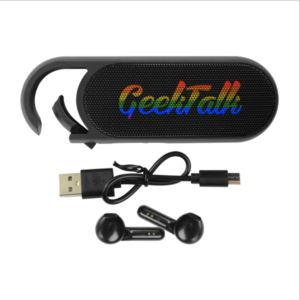
Sync Truly Wireless Earbuds and Bluetooth® Speaker Set
It’s a Bluetooth speaker! It’s your wireless earbuds! And it’s a carrying case…all in one! If you have a workforce or client base that loves tech, then this is a wonderful option for you. You and your team can clip this to your backpack and be ready to travel with tunes at all times. Click here to learn more.
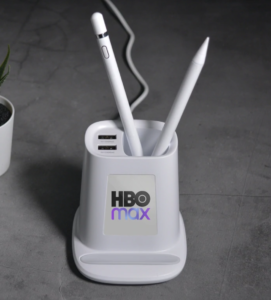
Desk QI
The Desk Qi is a tabletop charging hub and stationery holder, featuring up to 10W of fast wireless charging (powered by type-c), and 2 additional USB-A ports for your electronic devices. Showcase your brand or message up to a full-color imprint with this must-have at-home or office tech item! Click here to learn more.
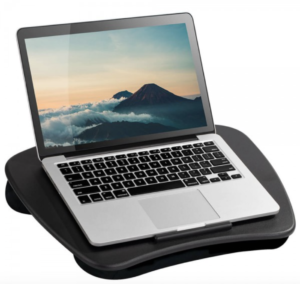
LAPGEAR Lap Desk with Device Ledge and Cushion Back
Most of us have set up amazing home offices and what do we do? We work from our couch! Whether you’re collating spreadsheets or indulging in a full-season binge of your favorite show, this Lap Desk is there for you. The 17″ x 13.2” work surface is made from durable, high-impact polystyrene and accommodates up to 15.6-inch laptops. Thanks to the reinforced carrying handle and compact size, you can take this desk with you wherever you go. This is the “tech” item that is not really tech. Click here to learn more!

Stress Pop Flyer
Want something decidedly less “tech” and more “touch?” We have you covered here. This stress pop flyer is fun for kids or seniors (think improving circulation) and everyone in between. This is a product that helps your brand to get back to fun. Click here to learn more.
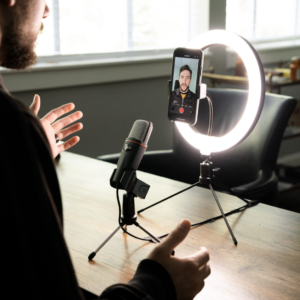
McStreamy – microphone and light ring
Look good, sound good, upgrade your virtual meeting game with the McStreamy kit. The bright 10″ ring light will keep you well lit and the studio-quality mic will make sure your audience hears every word. This is the perfect gift for your virtual team or your content team. And with this item…you can order just one! Click here to learn more!
Those are just 5 of the Hot New Branded Merch ideas we saw over the past few weeks! Now let’s talk about how we can help you create marketing that is “hot” this year. Please reach out to your HMC rep and set up a time to chat about your needs. Don’t have a rep? No worries. Click here to book a time to chat!
Oh…and make sure you never miss an update. You can become an HMC VIP here.
by Kirby Hasseman
Over the course of the past 18 to 24 months, most people’s lives have been changed. Some people have been totally upended, while others have been blessed to have come through the pandemic with just a few scratches. But either way, most of us have had the chance to look at our lives…and decide if we want to re-imagine them. This was not the time to put our head in the sand and “just wait it out.” It was the time to invest in ourselves.
One of the best ways to invest in yourself is by reading (or listening) to books.
I have talked quite a bit about game-changing books on this blog. Here is a list of 29 that I think everyone should check out. So what books have had my attention in 2021? Here are 10 of my favorite books from 2021.
Get Different
When Mike Michaelowicz writes a book, I line up to read it. I am almost never disappointed. This time Mike talks about why using “best practices” is a terrible way to stand out in a crowded marketplace. You can get your copy here.
The High 5 Habit
Mel Robbins has a way of speaking directly to my soul. Her latest book High 5 Habit highlights a concept so simple that it feels silly. But listen to this book and you will realize it’s not. I say “listen to this book” because Mel has a great delivery. She is very real…and I loved it.
Peak Mind
I have been a slow adopter of meditation. I still struggle to practice every day. In her book Peak Mind, author Amishi P. Jha shows the science and studies to help you understand why it’s a must. If we want to succeed in today’s world (and certainly tomorrow’s), we are going to need a Peak Mind.
Premonition
In a word…wow. As I mentioned at the beginning, we have all lived through a crazy time for the last 18 to 24 months. Premonition by Michael Lewis tells the story of the pandemic from behind the scenes. It opened my eyes to some of the challenges we have with public health, but also why some of the solutions can work…and not work. Really liked this one.
Cumulative Advantage
Why do some people succeed and others struggle? For some, they have an early advantage that they lean into. It’s their Cumulative Advantage. In this book, Mark talks about what that is, and how to create it even if you don’t begin with the headstart of privilege.
Promised Land
Let’s not get political here. I just wanted to learn some “behind the scenes” from the man in the White House. This one was interesting (and yes, political) and too long (and this is Part 1). But it does give insight into Obama’s vision for the country, and where he felt he did well…and where he failed. I thought it was totally worth my time. Find Promised Land here.
12 Months To $1 Million
Have you ever wanted to start a business selling items on Amazon? In the book 12 Months to $1 Million, you can learn how from someone who has done it more than once. Ryan Daniel Moran talks about how to find the perfect niche, create the right product, and then how to scale it up with new products. I have recommended this one to several people looking to start a business.
Soundtracks
We all have a voice playing on repeat in our heads…it’s our own. In his latest book Soundtracks, Jon Acuff talks about why that voice can really be our worst enemy if we allow it. And he gives real tactics to take your own voice back over (in a good way). This was probably one of my favorite books of the year…totally recommend this one.
Greenlights
I was a fan of Matthew McConaughey before this book. But the book Greenlights takes it up a notch for sure. McConaughey gives you incredible detail into his life and insights that I found powerful. I found this book to be fun, insightful, and surprising. And for me, the audiobook was the way to go for this. McConaughey narrates it himself and his gift as a performer shines through in the audio.
Think Like A Monk
The final book on my list is Think Like a Monk by Jay Shetty. Shetty tells the story of how he became a monk, and why he left. His insights into training the mind were great. I really enjoyed him explaining why we all need to have more “T.I.M.E.” in our morning if we want to have a more productive day.
So that is my list of 10 of my favorite books from 2021…so far. I have a few more I hope to finish (including the new Will Smith memoir) soon. If you want to keep learning and growing, how about one more book to consider? You can get the ebook version of my book “The Give First Economy” here. I would love for you to it check out…and share it with your team! Oh…and feel free to sign up for our weekly VIP newsletter here.
by Kirby Hasseman
If you are a marketer or an entrepreneur, you likely have more than a few challenges. But one of them is most likely, where to spend your time and resources. There is finite time and money, and you want to make sure you are doing the thing that will bring you the most return. Mike Michaelowicz turned me onto this idea in his book “Fix This Next.” Mike created a “Business Priority Pyramid” so that entrepreneurs can decide what is the right thing for them to be working on each day. I found this to be a powerful tool in order to make sure my efforts are going in the right direction.
But I find this to be a challenge for marketers too! There are so many marketing options to spend your time and resources on, it can be tough to know what to work on next. In addition, it seems like every day, a shiny new marketing tool comes out. As marketing professionals, we want to stay on top of the latest trends. But you don’t want to spend all of your time distracted by the newest toy…and lose out on the foundation.
That is why we created our HMC Marketing Pyramid

The concept is simple. We have created our HMC Marketing Pyramid as a worksheet for marketers. We have created levels so that you know where you are on your marketing journey. It also helps you prioritize what you need to work on next (or budget to work on soon). As you go through the pyramid, you want to check each box where you feel you are strong (or at least comfortable) where you are. After you go through the whole checklist, go to the lowest part of the pyramid where there is an unchecked box. That is where you need to start! You need to have a strong foundation if you want a pyramid that is going to last.
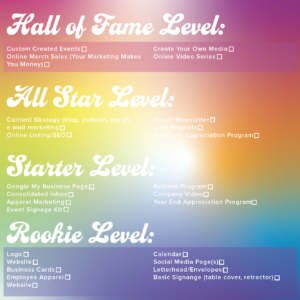
Rookie Level
If you love sports metaphors, you are going to dig this. If not, think of this as the foundation of your marketing plan. You might be starting a new venture, or you want to get back to basics. You start at the Rookie Level. At that level, you want to make sure you are happy with your logo, basic branding, website, and more. If you leave something un-checked here, no problem. It just shows you that it’s time to work on that to move your marketing efforts to the next level.
Starter Level
And speaking of the next level, now you are a starter! At this level, you have mastered the basics and you want to begin to be more intentional and more consistent. This is when you “up your game” on communication and letting your best customers know you love your fans.
All-Star Level
All-stars take it to the next level, and that is exactly what this ranking means. Once you have completed all of the tasks at Rooke and Starter, you can take bigger swings. Sure you have social media pages, but do you have a plan? Have you made the transition from rented media to owned media? I talk about what that means here. This is what happens at the All-Star level.
Hall of Fame
Marketers and entrepreneurs at the Hall of Fame level are truly building brands. They have custom events to showcase their services and to connect with their tribe. Many also feature custom apparel that their customers actually pay to wear! Now THAT is a brand!
So where do you land on the HMC Marketing Pyramid? This is a jumping-off tool to help you plan what should be next for marketing your organization. Let us know if you want to meet with one of our Hasseman Marketing reps to go over the pyramid…and plan the next steps!
And in case you missed it, feel free to sign up for our FREE 5 Day Marketing Course. We would love to help you get your marketing back on track!
by Kirby Hasseman
I love blogs, podcasts, and videos. Each of these has the chance to inspire me and lift me up. I have created time in my morning routine to put some good into my brain each day…and these are often my tool of choice. But if I really want to take a deep dive into a topic, I still am inspired by books. Whether I read a physical book or simply take a walk with the author (in audio form), books help me grow (and level up).
Over the course of the last 10 years, I have had the chance to read hundreds of books. Some have been forgettable. Others have been what I needed to hear at the moment. But here is a list of 29 Game-Changing Books for Business that have impacted me. I wanted to share them with you.
The E-Myth Revisited
This is one of the best business books ever. I have bought countless copies and have recommended it more times than I can remember. I have probably read it 10 different times and have found myself in a different place on the journey each time. If you are in business or want to start a business, this is awesome.
Profit First
When I first listened to Profit-First, I thought author Mike Michaelowicx was following me around. It spoke to the challenges I was having in my business’s cash flow right then. We tentatively adopted the philosophy and have not looked back. It’s been a game-changer for us. Mike’s goal is to “eliminate entrepreneurial poverty,” and for many in business, that is a real thing. Love this book.
Start with Why
You know a book is powerful when it becomes something that everyone else repeats. It seems every business leader discusses the need to find your WHY now. Sinek created the conversation and it is an important one in today’s business world.
Leaders Eat Last
I think each one of Sinek’s books has gotten stronger. And while I really enjoyed “Start with Why,” I thought “Leaders Eat Last” was even better. Sinek goes into what makes a great leader and even the biological reasons for it. Powerful information…and super interesting too!
Infinite Game
As you might expect, this is my favorite of Simon Sinek’s books. He explains the difference between a finite game and an infinite game and why it matters so much to know what kind of game you are playing. For me, it crystallized the idea of playing a “long game” in business. It’s what I have long believed and discussed, but Sinek does it in a much more articulate way than me!
The Thank You Economy
I love Gary Vaynerchuk. I am a fan. But while I love his content, his energy, his speaking, and his philosophy, I don’t always LOVE his books. But The Thank You Economy was different. Gary talks about using social media to create appreciation, value, and connection at scale. Loved this one.
Pumpkin Plan
This is the second Mike Michaelowicz book on the list. I am a fan of Mike’s work and this is a powerful one about differentiation. He says “The Riches are in the Niches” and explains how to find your niche and grow into it. He even spends a bit of time explaining how to “fire a client” which just seems so hard for some entrepreneurs. The Pumpkin Plan is worth harvesting.
Purple Cow
I am an unapologetic fan of Seth Godin. He is a thought leader in business and marketing. And he has the ability to say things in a way that is simple, yet powerful. “If you want to be remarkable, you have to do something worth remarketing about.” Read this one if you want to stand out in a crowded marketplace.
The Dip
While this is probably not Godin’s most famous book, it is the one I find myself quoting the most often. It’s short and powerful. When you start something new, you will be learning fast and your improvements will be fast. Then, that will excitement and progress will slow down. It will not be as exciting. This is the Dip…and it’s when most people quit. Get through the Dip…and you become the expert.
The Practice
His most recent book (as I type this), The Practice is a powerful reminder about how we get better at anything. If you want to build a career, a business, your fitness, content, or a life…creating a Practice will help you do it.
Ultimate Selling Machine
If you are an entrepreneur or are in sales (and we are all in sales), this book is powerful. There are strategies for everything from creating a sales process to building real relationships. Love this one.
High Trust Selling
I read this one a long time ago, and it was one of the first books that changed my business. Duncan’s observation is that 80% of our results in sales come from 20% of activities. But as salespeople, we tend to focus on the wrong part of the business. We need to hire out the 80% that does not make us money.
The 5 Second Rule
File this under “simple but powerful.” Mel Robbins gives you a 5, 4, 3, 2, 1 solution for procrastination. Along the way, she gives powerful insights into performance and life. Oh…and this is a great audiobook if you enjoy those.
Finish
Jon Acuff is a great writer and speaker. His sense of humor helps me get lessons I might otherwise miss. While I love his book Start (Punch Fear in the Face), the book Finish was more powerful for me. I have never had problems starting things…but finishing? Squirrel! He gives some great tips on getting your project to the finish line.
7 Habits of Highly Effective People
I talk about this book as a foundational book for anything. I find myself referencing it years later. If you have read it. Read it again.
The Goal
I got this book recently at the recommendation from a friend. It’s a great look at how to improve a bottleneck and flies in the face of traditional manufacturing policy.
Known
Want to build your personal brand? I really enjoyed this book from Mark Schaeffer on how to make it happen. In this book, he outlines the 5 steps you need to take to build your brand and become Known.
Building Your Storybrand
Donald Miller wrote this gem that outlines why most companies get their marketing wrong. It was a real “a-ha” moment for me and shined a light on why sometimes messages work and sometimes they don’t. Who is your marketing making “the hero of the story?” Most of us make ourselves the hero. The customer needs to be the hero. Miller explains why in this wonderful book.
Marketing Made Simple
Now that you understand that the customer needs to be the hero of your marketing story, Marketing Made Simple digs into the tactics of how to make that happen. This book outlines a step-by-step process to create a marketing machine that works for your business.
Dare To Lead
Most of us are afraid to put ourselves out there. We don’t want to be completely authentic because it doesn’t feel like “what a strong leader would do.” Brene Brown breaks down those myths and challenges us to lean into them. I feel like this book made me a better leader by making me a better person.
Extreme Ownership
And speaking of leadership, it’s hard to learn from better teachers than Jocko Willink and Leif Babin. These two team up to give amazing lessons in leadership combined with stories from leading teams in combat. Oh…and if something is going wrong in your company, or division, or family…you should take extreme ownership. Good one here.
Meditation for Fidgety Skeptics
Everywhere I looked, I saw people telling me I needed to meditate. But I didn’t know how to do it. I felt like I was doing it wrong. It felt strange and weird. This book breaks down some of those myths and gives you permission to get started with “just one minute” if that’s what you need to do. This is a good introduction for someone that feels they might need meditation in your life…but does not know where to start.
The Subtle Art of Not Giving a F*ck
If you are offended by strong language, this book is not for you. However, if you can get past that, there is a zen-like quality to much of this book that really connected with me. One of my favorite lessons, which I talk about here, is the idea that successful people are willing to “suffer through” things to get to what they want. Not everything will be easy. If you want to reach your goal, you need to decide what you are willing to suffer through.
Scrum
This book is sort of the bible for Agile productivity. We read it as a team. If you want to get more done as a team, this book is a must-read. Can you break down tasks into small enough pieces so that every member of the team can help? You probably can…and SCRUM lines up how.
4 Disciplines of Execution
Let me see if you have been there. We come back from a conference (or read a book) and want to implement a great idea. We start strong, but then the “whirlwind” of business and life gets in the way. The 4 Disciplines break down how to identify the Wildly Important Goal, and create a process to make improvements with your team.
Epic Content Marketing
If you want to do content marketing “right,” this is your manual. Joe Pulizzi talks about the start of his company and how creating compelling content (for the customer) works. He shows you how to create an audience and story-tell in a way that will build your brand. Loved this one.
Hug Your Haters
So you have created a social media following that is worth having. What do you do when “the haters” show up? Jay Baer says you need to “Hug Your Haters” in this book about dealing with tough comments on social. Jay gives the playbook on what to do when complaints happen (and they will). Most of us want to ignore the comments so they go away. Jay explains why that is the wrong play…and how doing it right can change haters into fans!
Never Split the Difference
Life is a negotiation. If you are in business, you already know this. In this powerful book, Chris Voss takes us inside some amazing stories from a hostage negotiator…and how many of them can apply to you.
Living With a Seal
And I wanted to end with a fun one. Jesse Itzler tells the story of how he invited the “toughest man on the planet” David Goggins to live with him for a month and train him. When I listened to this, no one knew who David Goggins was…but it all makes sense now. While there are some sincere lessons here about how far we (as humans) can go, this one was fun.
So there you go. Here are 29 game-changing books for business and personal development. These are books that have helped me level up in business and life.
If you enjoy reading and looking for ways to grow and level up, you might want to learn more about our new Better Business University. We are creating an affordable online learning platform that can help you take your career to the next level.
Make sure you never miss an update by signing up for our VIP newsletter here. Oh…and as always, we have all of our content here on our blog page…check it out!
